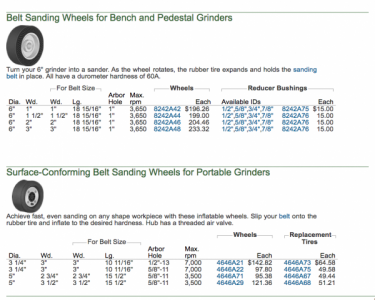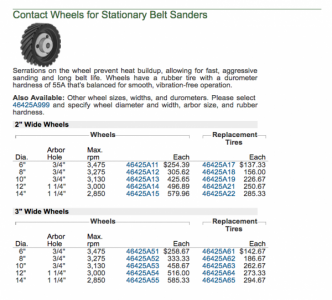- Joined
- Apr 21, 2015
- Messages
- 894
This morning I saw a video on YouTube where a knife maker was using an abrasive belt on a rubber grinding wheel on a surface grinder. He only had very tight shots, just barely wide enough to show that the belt does separate from the wheel, confirming the obvious assumption that it's a larger belt than the wheel. It appeared to be an older machine, not a purpose-built "surface grinder". Fascinating. Searching I'm having trouble finding much information about this. I see that Tormach has an attachment for their surface grinder that does this, but it seems to be much more involved than this other guy was using, and it's made for a specific machine.
I have a good assortment of grinding wheels for precision work. But sometimes I just want to remove machining marks and make it look good, and that can be very time consuming with grinding wheels. A ceramic belt would be ideal there. I've been building a 2x72 type grinder (I started 18 months ago, then it was put on hold when I had a series of commissioned woodworking projects, and I just resumed it this past week) which I had expected to use for that purpose, among many others, but it's difficult to keep a part flat when moving it across the belt. I had planned on coming up with a jig for that (most likely utilizing two ball bearing drawer glides, mounted perpendicularly to each other to provide reasonable alignment in both axes), but now I'm thinking this would be a better solution since I already have a surface grinder with excellent table movement. It just needs a way to mount/tension/track an abrasive belt. And there are at least six threaded bolt holes plus t-track mounts on the spindle housing.
Has anyone here ever seen such a retrofit?
I'm typing this on the computer, but the link to the video is on my phone. I'll add it in the first comment below. I did ask the guy in a comment on his video, but he hasn't uploaded anything in 2 years so I don't expect a response any time soon.
I have a good assortment of grinding wheels for precision work. But sometimes I just want to remove machining marks and make it look good, and that can be very time consuming with grinding wheels. A ceramic belt would be ideal there. I've been building a 2x72 type grinder (I started 18 months ago, then it was put on hold when I had a series of commissioned woodworking projects, and I just resumed it this past week) which I had expected to use for that purpose, among many others, but it's difficult to keep a part flat when moving it across the belt. I had planned on coming up with a jig for that (most likely utilizing two ball bearing drawer glides, mounted perpendicularly to each other to provide reasonable alignment in both axes), but now I'm thinking this would be a better solution since I already have a surface grinder with excellent table movement. It just needs a way to mount/tension/track an abrasive belt. And there are at least six threaded bolt holes plus t-track mounts on the spindle housing.
Has anyone here ever seen such a retrofit?
I'm typing this on the computer, but the link to the video is on my phone. I'll add it in the first comment below. I did ask the guy in a comment on his video, but he hasn't uploaded anything in 2 years so I don't expect a response any time soon.



